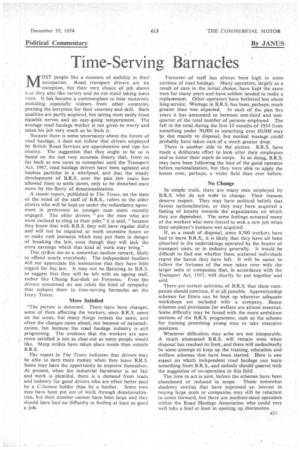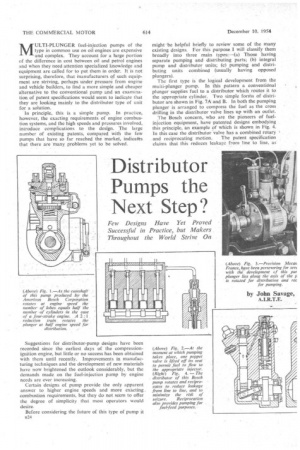Time-Serving Barnacles
Page 57

Page 58

If you've noticed an error in this article please click here to report it so we can fix it.
MOST people like a measure of stability in their occupation. Road transport drivers are no exception, but their very choice of job shows tat they also like variety and do not mind taking some risks. It has become a commonplace to hear motorists, including especially visitors from other countries, praising the lorrymen for their courtesy and skill. Such qualities are partly acquired, but spring most easily from equable nerves and an easy-going temperament. The average road haulage worker is not given to worry and takes his job very much as he finds it.
Because there is some uncertainty about the future of road haulage, it does not follow that drivers employed by British Road Services are apprehensive and ripe for mutiny. The suggestion that they ought to be so is based on the not very accurate theory that, from as far back as one cares to remember until the Transport Act, 1947, road haulage drivers have been agitated and hapless particles in a whirlpool, and that the steady development of B.R.S. over the past few years has allowed them to settle down, only to be disturbed once more by the flurry of denationalization.
A recent report, published in The Times, on the state of the mind of the staff of B.R.S., refers to the older drivers who will be kept on under the redundancy agreement in preference to younger men more recently engaged: The older drivers "are the men who are most inclined to cling to their jobs," it is said, "because they know that with B.R.S. they will have regular shifts and will not be required to work excessive hours or to make rush jouriaeys which may put them in danger of breaking the law, even though they will lack the extra earnings which that kind of work may bring."
This strikes me as a somewhat tactless remark, likely to offend nearly everybody. The-independent hauliers will not appreciate the insinuation that they have little regard for the, law. It may not be flattering to B.R.S. to suggest that they willbe left with an ageing staff, rather like Chiang Kai-shek on Formosa. Even the drivers concerned do not relish the kind of sympathy that reduces them to time-serving barnacles en the Ivory Tower.
More Satisfied The picture is distorted. There have been changes, some of them affecting the workers, since B.R.S. came on the scene, but many things remain the same, and often the changes came about, not because of nationalization, but because the road haulage industry is still progressing. The evidence that the workers are now more satisfied is not as clear-cut as some people would like. Mor,e strikes have taken place inside than outside B.R.S.
The report in The Times indicates that drivers may be able to earn more money when they leave B.R.S. Some may have the opportunity to improve themselves. At present, when the industrial barometer is set fair and work is plentiful, there is a demand from trade and industry for good drivers who are often better paid by a C-licence holder than by a haulier. Some men may have been put out of work through denationalization, but their number cannot have been large and they should have had no'difficulty in finding at least as good a job. Turnover --.of staff has. always been high in some sections of road haulage. Many operators, largely as a result of care in the initial choice, have kept the same men for many years and have seldom needed to make a replacement. Other operators have bothered less about long service. Wastage in B.R.S. has been, perhaps, much greater than was expected. In each of the past five years it has amounted to between one-third and onequarter of the total number of persons employed. The fall in the total during the first 10 months of 1954 from something under 70,000 to something over 60,000 may be due mainly to disposal, but normal wastage could probably have taken care of a much greater drop.
There is another side to the picture. B.R.S. have made a deliberate effort to look after their employees and to foster their esprit de corps. In so doing, B.R.S. may have been following the lead of the good operator before nationalization, but they were able to apply the lesson over, perhaps, a wider field than ever before.
No Change In simple truth, there are many men employed by B.R.S. who do not watt to change. Their reasons deserve respect. They may have political beliefs that favour nationalization, or they may have acquired a feeling of loyalty towards the organization on which they are dependent. The same feelings actuated many of the workers who were forced to seek a new job when their employer's business was acquired.
If, as a result of disposal, some 8,500 workers have had to leave B.R.S., it is likely that they have all been absorbed in the undertakings operated by the buyers of transport units, or in industry generally. It would be difficult to find out whether these scattered individuals regret the haven they have left. It will be easier to follow the fortunes of the men taken over with .the larger units or companies that, in accordance with the Transport Act, 1953, will shortly be put together' and sold.
There are certain activities of B.R.S. that these cornpanic§ should continue, if at all possible. Apprenticeship schemes for fitters can be kept up wherever adequate workshops are included with a company. Bonus schemes and provisions for welfare are almost essential. Some difficulty may be found with the more ambitious sections of the B.R.S. programme, such as the scheme for training promising young men to take executive positions.
Whatever difficulties may arise are not insuperable. A much attenuated B.R.S. will remain even when disposal has reached its limit, and there will undoubtedly be some attempt to keep up the training, education and welfare schemes that have been started. Here is one aspect on which independent road haulage can learn something from B.R.S., and nobody should quarrel with the suggestion of co-operation in this field.
The time to act is now, before the schemes have been abandoned or reduced in scope. Those somewhat shadowy entities that have expressed , an interest in buying large units or companies may still be reluctant to come forward, but there are medium-sized operators within the Road Haulage Association who could very well take a lead at least in opening up discussions.
MULTI-PLUNGER fuel-injection pumps of the type in common use on oil engines are expensive and complex. They account for a hirge portion of the difference in cost between oil and petrol engines and when they need attention specialized knowledge and equipment are called for to put them in order. It is not surprising, therefore, that Manufacturers of such equipment are striving, perhaps under pressure from engine and vehicle builders, to find a more simple and cheaper alternative to the conventional pump and an examination of patent specifications would seem to indicate that they are looking 'mainly to the distributor type of unit for a solution.
In principle, this is a simple pump. In practice, however, the exacting requirements of engine combustion systems, and the high speeds and pressures involved, introduce complications to the design. The large number of existing patents, compared with the few pumps that have So far reached the market, indicatts that there are "many problems yet to be solved. might be helpful briefly to review some of the many existing designs. For this purpose I will classify them broadly into three main types:—(a) Those having separate pumping and distributing parts; (b) integral pump and distributor units; (c) pumping and distributing units combined (usually having opposed plungers).
The first type is the logical development from the multi-plunger pump. In this pattern a conventional plunger supplies fuel to a distributor which routes it to the appropriate cylinder. Two simple forriis of distributor are shown in Fig. 7A. and B. In both the pumping plunger is arranged to compress the fuel as the cross drilling in the distributor valve lines up with an outlet.
The Bosch concern, who are the pioneers of fuelinjection equipment, have patented designs embodying this principle, an example of which is shown in Fig. 4. In this case the distributor valve has a combined rotary and reciprocating motion. The patent specification claims that this reduces leakage from line to line, as




















































































































